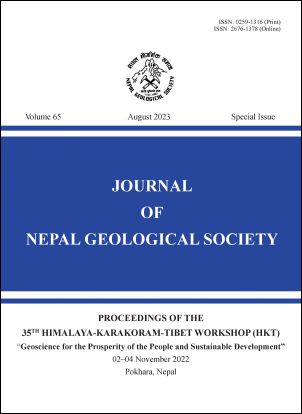Geological study along Sipaghat-Panchkhal-Sukute area, Kavreplanchowk and Sindhupalchowk districts, Lesser Himalaya, central Nepal
DOI:
https://doi.org/10.3126/jngs.v65i01.57772Keywords:
Main central thrust (MCT), protolith, recrystallizationAbstract
A detailed geological study has been carried out in the Lesser Himalayan rocks distributed in Panchkhal-Dolalghat- Sukute area in Kavre Palanchowk and Sindupalchowk districts. The study area belongs to Kuncha Formation of Lower Nawakot Group, Benighat Slate of Upper Nawakot Group, Nawakot Complex; Raduwa Formation, Bhaisedobhan Marble, Kalitar Formation, Chisapani Quartzite, Kulikhani Formation, and Markhu Formation of Bhimphedi Group and Tistung Formation of Phulchauki Group, Kathmandu Complex. These two complexes are separated by the Main Central Thrust (MCT). Four lithounits of the Lower Nawakot Group (i.e., Fagfog Quartzite, Dandagaon Phyllite, Nourpul Formation and Dhading Dolomite) and two lithological units (Malekhu Limestone, Robang Formation) of the Upper Nawakot Group are missing in the area. The area comprises intercalation of coarse-grained, thick bedded quartzite and gritty phyllite of Kuncha Formation, dark argillaceous slates with Jhiku Carbonate beds including sporadic amphibolite of the Benighat Slate. The Bhimphedi Group of the Kathmandu Complex comprises mainly micaceous schist, marble, metasandstone and augen gneiss whereas the Phulchauki Group comprises of metasandstone and granite. The lithological units strike NW-SE and dip towards south forming the eastern closure of the Mahabharat Synclinorium in the northern limb.
Downloads
Downloads
Published
How to Cite
Issue
Section
License
© Nepal Geological Society




